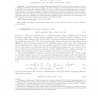Free Online Productivity Tools
i2Speak
i2Symbol
i2OCR
iTex2Img
iWeb2Print
iWeb2Shot
i2Type
iPdf2Split
iPdf2Merge
i2Bopomofo
i2Arabic
i2Style
i2Image
i2PDF
iLatex2Rtf
Sci2ools
NA
2010
2010
Semi-definite programming techniques for structured quadratic inverse eigenvalue problems
In the past decade or so, semi-definite programming (SDP) has emerged as a powerful tool capable of handling a remarkably wide range of problems. This article describes an innovative application of SDP techniques to quadratic inverse eigenvalue problems (QIEPs). The notion of QIEPs is of fundamental importance because its ultimate goal of constructing or updating a vibration system from some observed or desirable dynamical behaviors while respecting some inherent feasibility constraints well suits many engineering applications. Thus far, however, QIEPs have remained challenging both theoretically and computationally due to the great variations of structural constraints that must be addressed. Of notable interest and significance are the uniformity and the simplicity in the SDP formulation that solves effectively many otherwise very difficult QIEPs. AMS subject classifications. 65F18, 15A22, 93B55 Key words. semi-definite programming, quadratic pencil, inverse eigenvalue problem, s...
| Added | 29 Jan 2011 |
| Updated | 29 Jan 2011 |
| Type | Journal |
| Year | 2010 |
| Where | NA |
| Authors | Matthew M. Lin, Bo Dong, Moody T. Chu |
Comments (0)

